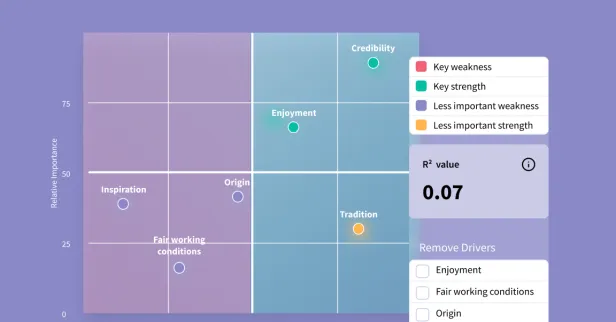It can be tempting to try and give your customers every single product, feature, or service they ask for. But no matter how ambitious your brand is, the fact remains; you can’t do it all.
In fact, trying to fulfill every whim will only end up straining your time, capital, and energy. Instead, you have to strike a delicate balance of providing just enough variety without overextending your resources.
That’s exactly why many companies turn to TURF analysis to help them carefully choose the right combination of products, features, or messaging to maximize their reach.
Sound interesting?
Keep reading to learn how to you can use TURF analysis in your own consumer research to expand your appeal within your target market.
What is TURF Analysis?
TURF stands for Total Unduplicated Reach and Frequency.
It's a statistical methodology used in consumer research to find an optimal mix of offerings (like products, features, or message points) that appeal to the maximum number of people in the most efficient and cost-effective way.
If that sounds a bit complicated initially- don't worry. It’s actually quite simple! 😎
In survey research, TURF is used to analyze questions where respondents select options they prefer from a set. It uses that data to uncover the combination of options that has the highest unduplicated reach.
Unduplicated being the keyword.
Whether the options you’re testing are new products, features, or messaging- some options will likely appeal to similar audiences or even overlap with your existing offerings. The goal of TURF is to identify which options have the least overlap, so that the combination you select appeals to the largest number of people.
Why is TURF Analysis Useful?
If you’re still a bit unclear on TURF's practical use cases in consumer research- let's take a look at an example.
Say your company makes hand soap. You already have 5 high-selling scents, but you’re ready to expand your SKUs. So, your innovation team comes up with 15 new scents:

No matter how great all of the new scents are, you know you can’t develop them all.
Why? Because it would be incredibly time-consuming and cost-prohibitive to manufacture and ship each individual product. Not to mention the marketing and messaging lift.
Looking at the logistics, you can feasibly move forward with 3 new scents out of the 15.
So now, you’ve got to choose.
You could just pick your favorites- but that wouldn’t be all that helpful. Realistically, you need to select the scents that will help you expand your customer base.
So, you turn to research.
Running a survey with your target market, you include a multi-select question presenting respondents with all of your current and proposed scents, asking them to select all they would consider purchasing.
Now, if you were to just look at purchase intent scores, you might find that Watermelon Mint, Orange Ginger, and Warm Vanilla Almond came out on top.
But if you chose those scents, you’d be missing out on a big opportunity to expand your reach.
Why?
It turns out that people who preferred Warm Vanilla Almond also liked your Vanilla Bean scent. Cucumber Mint and Watermelon Mint were also preferred by the same respondents. And- you guessed it- the same goes for Citrus Burst and Orange Ginger.
So instead of expanding your market, you would likely just cannibalize the sales of your most popular products- had you selected the three original winners.
But a TURF analysis could tell you a very different story.
While adding the Vanilla Bean, Watermelon Mint, and Orange Ginger scents to your current lineup would appeal to 75% of the consumers you surveyed, it turns out there is a better combination for optimal reach.
In fact, by instead adding the Fig & Honey, Cedarwood & Frankincense, and Coconut scents to your inventory your appeal score rises to 94%- greatly expanding the reach of your hand soap portfolio.
When Can I Use a TURF Analysis?
When it comes to applying TURF analysis to your research, the possibilities are (nearly) endless.
For marketers, TURF analysis will give you insights into the combination of message points that will appeal to the greatest number of people. Similarly, you can use it to understand which channels would work best for reaching new or larger audiences.
In product development, TURF analysis enables you to pick the perfect mix of product features that will attract the most potential customers.
And if you’re a consumer goods brand that deals with product flavors, colors, or other variations- TURF analysis can help you understand the market appeal to expect when launching something new. It will also tell you whether your newest product will encroach on the market of any of your existing offerings.
Automated TURF Analysis with SightX
We’ve made TURF analysis more intuitive than ever before with our latest feature drop!
Whether you're testing new products, features, or messaging- it's now easier than ever to experiment with different scenarios and identify a winning combination to expand your reach.
After you’ve run a survey, you can head over to the TURF analysis section of SightX and choose one of the multi-select questions you included in your project. The applicable questions will auto-populate in the dropdown menu that appears:
Next, you can use the Optimal Combination Simulator to choose the number of options you’d like to include in your combination. If you're not quite settled on a number yet, you can see the unduplicated reach for each number of options to help you better decide.
Below, you can see that the jump in reach between 4 options and 5 is quite large (21%) compared to the difference between 5 and 6 (1%). This will help you quickly evaluate the reach associated with each number of options.

For this example, let’s say we’ve chosen 5 options.
From there, the Optimal Combination Simulator will give you a breakdown of the five top combinations and their reach. In the example below, you can see that the top combinations for our data would be combination 1 or combination 2. Meaning we could select either.

Now, for situations like our first use case, where we are testing the reach of both our current AND new scents- we’ll want to handle things a little differently.
When looking at the optimal combinations, we’ll want to use the dropdown on the right-hand side and select “always include” for our 5 current scents. This will ensure that each combination shown will always have Vanilla Bean, Spiced Pear, Cucumber Mint, Eucalyptus, and Citrus Burst incorporated.
And, if for some reason after running our study, we decide that one of the new scents is just too difficult or expensive to manufacture, we can hit “always exclude” next to that option to remove it from contention.

Getting Started with TURF Analysis
If you’re ready to level up your insights, we’ve got the tools to make it happen!
The SightX platform is the next generation of market research tools: a single unified solution for consumer engagement, understanding, advanced analysis, and reporting.
With the new addition of our TURF Analysis Simulator we have made it easier than ever to get insights on the products, features, and message points that will expand your reach.
Whether you are ready for a total DIY experience or prefer a little more support and guidance- we’ve got you covered. Start a free trial today!
